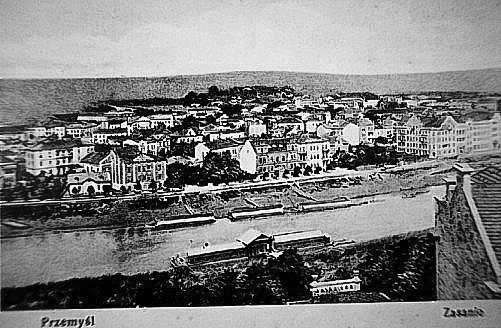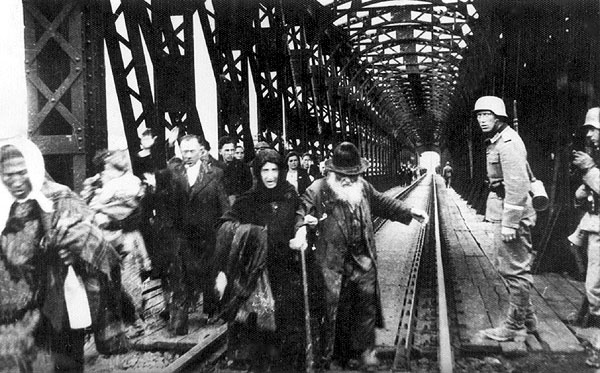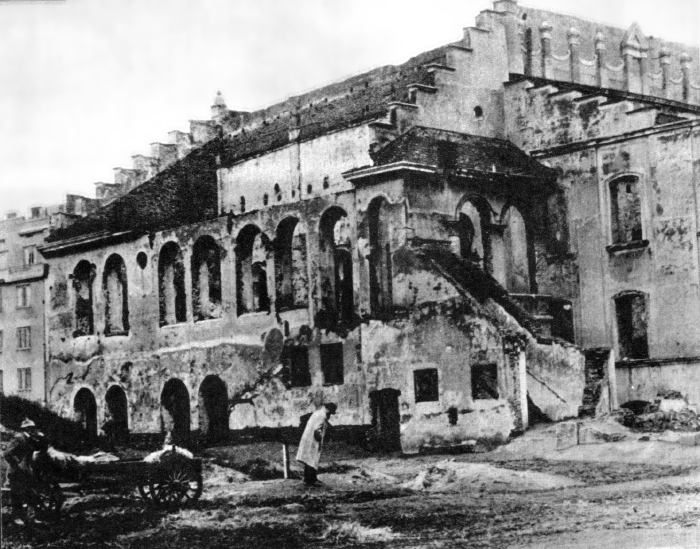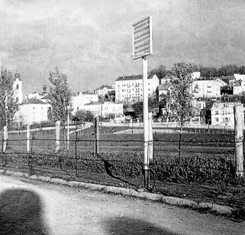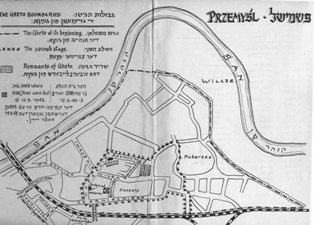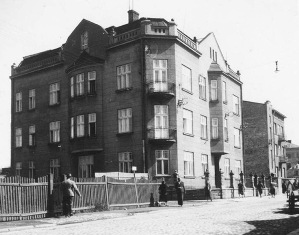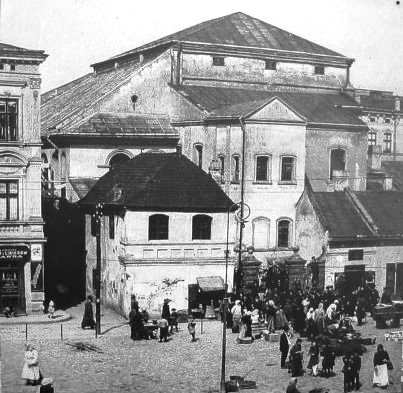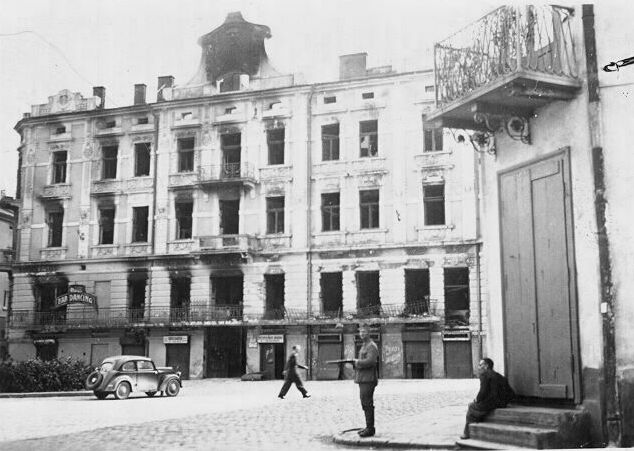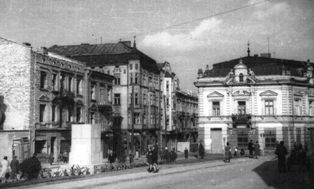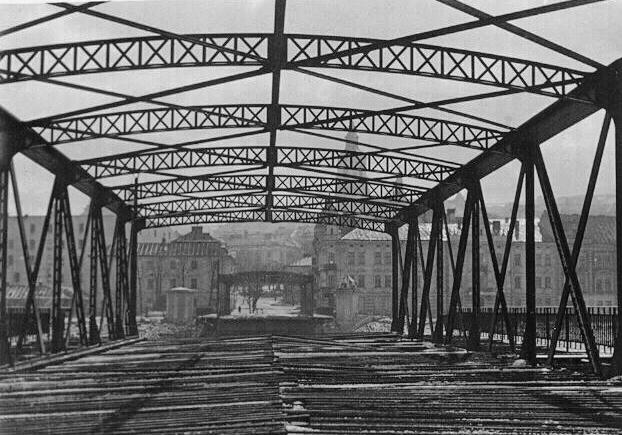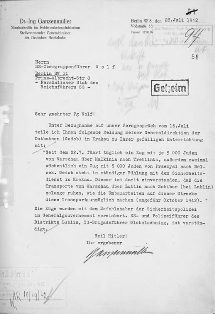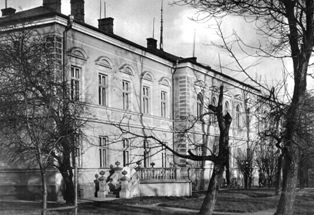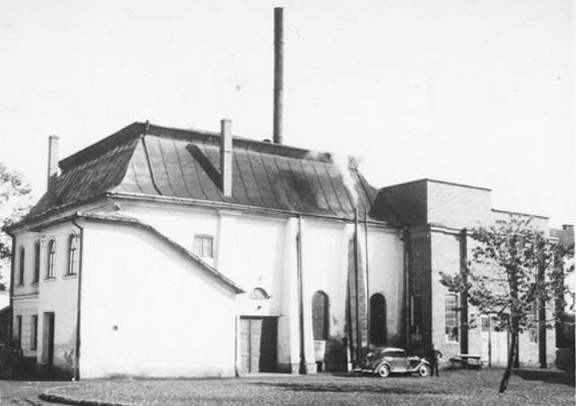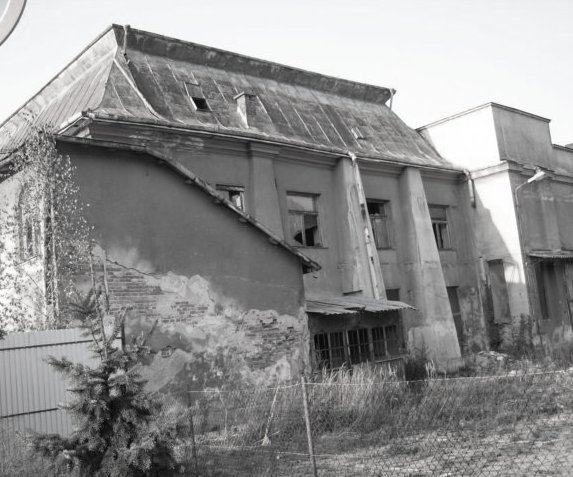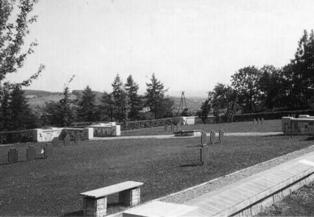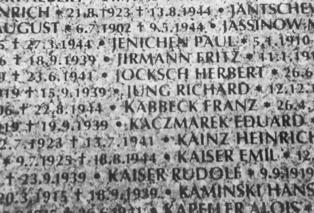Holocaust Education & Archive Research Team |
Ghettos
Introduction to the Ghettos of the Holocaust
Jewish Ghettos The Judenrat Judenrat Leaders Prominent Jews
| ||||||||
Przemysl
Przemysl is a city in Poland, situated on the San River, in the Lvov district, Eastern Galicia and before the Second World War approximately 24,000 Jews lived in Przemysl.
The Germans bombed Przemysl on 7 September 1939 and the following day the bombing continued setting fire to the shopping centre Pasaz Gansa.
Many of Przemysl inhabitants fled the city, to escape the bombings, and the Germans entered the city for the first time on 15 September 1939, approximately 20, 000 Jews lived in Przemysl, including refugees from western Poland.
The Germans immediately began to humiliate the Jewish inhabitants and started to arrest members of the Jewish intelligentsia, physicians, lawyers, industrialists and Jewish political activists. Forty-three leading Jewish citizens were arrested, taken for forced labour, savagely beaten and then shot. Among the forty-three was Asscher Gitter, whose son had emigrated to the United States in 1938, hoping that one day his father would join him.
Jews were taken from their dwellings by members of the Sicherheitspolizei or were rounded up on the streets and taken to nearby woods surrounding Przemysl where they were shot and buried in communal graves. The first mass executions of approximately 600 Jews took place between 16 and 19 September 1939, at a number of places in the cities outskirts, these included Lipowica, Pralkowce also at Przekopana near the Wiar River and near the Jewish cemetery at Slowackiego Street.
On 23 September 1939 notified the inhabitants of Przemysl that the San River was the demarcation line between the German and Soviet areas. On 28 September 1939 the Soviets took possession of the city. Shortly before the withdrawal the Germans burnt down the Old Synagogue, the Klois, the Hassidic prayer house, the Tempel Synagogue on Jagiellonska Street and parts of the Jewish quarter.
As in other places that fell into Soviet hands in 1939, the lives of Jews changed greatly. Jewish cultural and political activity, especially religious and Zionist the Soviets ended.
Private industries and businesses were turned into co-operatives and in April and May 1940 about 7,000 Jews were deported to the Soviet interior.
On 26 September, Jewish inhabitants of Zasanie and villages on the German side of the San River were ordered to move to the Russian occupied part of Przemysl. Since the bridge over the San had been bombed by the Germans, the Jews could only reach the eastern part of the city only via the railway bridge. Later this crossing was prohibited for all civilians especially Jews.
On the German side whilst most of the Jews had been moved to the Soviet side, only a handful were left, 66 in all mostly women, elderly and sick were later housed in two buildings on 11/13 Dolinskiego Street.
Around the turn of the year in 1940 the Frontier Police Authority (Grenzpolizeikommissariat) was set up, and their job was to ensure that movement across the border area was restricted.
On 27 June 1940 the German part of Przemysl was re-named Deutsch- Przemysl and for two years became a collection point for ethnic Germans returning “home.”
In January 1940 Heinrich Himmler and Hanns Johst, a writer, were both at the bridge over the San River to greet ethnic Germans, and Johst recalled “all the returnees bow deeply and faithfully to this greeting, which is for them a promise and the host of infinite happiness.”
Deutsche- Przemysl included the areas Zasanie, Ostrow, Kunkowce, Buszkowce, Buszkowiczki, Zurawica, Walawa, Przekopana, Polnocna, and parts of Ujkowice and Bolestraszyce.
In the spring of 1940 a Judenrat was established in Zasanie – this was probably the only Judenrat in occupied Poland headed by a woman, Anna Feingold.
Anna Feingold exact fate is unknown, but in all probability she was probably shot by the Germans in Lipowice, prior to the first mass deportations.
With Operation Barbarossa, the German invasion of the Soviet Union the Germans reoccupied Przemysl on 28 June 1941 some 17,000 Jews were living there. The Nazis immediately began rounding up Jews for forced labour. On their own initiative the Jews established a committee to represent themselves, headed by Dr. Ignatz Duldig.
Within a few days the Gestapo arrived and enforced anti-Jewish measures, such as the wearing of the Jewish badge, the registration of all Jews in the labour office, and the establishment of a Jewish Council (Judenrat) under Dr Duldig.
During the following year Jews were forced to hand over their valuables and various household goods. Those who did not comply with the Nazi decrees were beaten and imprisoned.
In August 1941, Galicia was incorporated into the General Government and Przemysl was administratively reunited under its former name and with the surrounding municipalities it now formed the Kreishauptmannschaft Przemysl, under Stadtkommissariat and Landkommissariat Dobromil.
The Grenzpolizeikommissariat a department of the Sicherheitspolizei, and a Criminal Investigation Department were all under the command of SS- Untersturmfuhrer Weichelt. The premises of these departments were separated from each other, but were under the sole command of the Befehlshaber der Sicherheitspolizei and the SD Dr Schongarth in Krakow.
Furthermore Przemysl became headquarters of the Gendarmarie under Hauptmann Hassler as well as a regular police which utilised Polish and Ukrainian volunteers and one company of Police Battalion 307.
After the occupation the GPK Przemysl was housed in the Gestapo Headquarters, a multi-storied private house on Ulica Krasinskiego.
In charge of the GPK Przemysl until May 1941 was Kriminal-Kommissar Freidrich Preuss, who was succeeded by SS-Untersturmfuhrer Adolf Benthin, who was replaced by SS-Sturmscharfuhrer Rudolf Heinrich Benewitz and finally by SS- Hauptsturmfuhrer Weichelt in early 1944 until the unit was dissolved in July 1944.
The GPK was responsible for the surveliance of the Jews in Przemysl and Sturmscharfuhrer Richard Timme was responsible for Jewish matters, although economic administration was still under the authority of the Kreishauptmannschaft.
The conditions for the Jews deteriorated sharply in the summer months of July and August 1941 as the Nazi grip tightened, in late autumn 1941 the quarter of Garbarze was proclaimed as the Jewish residential area. It was bordered East, North and West by the bend of the San River and in the South by the Lvov – Krakow railway route.
The establishment of the Jewish Quarter lasted until the summer of 1942, with Jews being allowed to walk freely through the streets, only the crossing to Zasanie via the provisional bridge was prohibited for Jews.
On 26 December 1941 Schutzpolizei along with Volksdeutsche and Polish policemen entered Jewish homes and seized furs and other clothing, destined for German troops fighting on the Russian front. Schutzpolizei officers started to remove furs and fur collars from the coats of all Jewish men and women they met in the streets. They also removed winter boots, particularly from women and made them walk with bare-feet in the cold.
From the spring of 1942 there were numerous executions of Jews by shooting at the Jewish cemetery at Slowackiego Street. These shootings were carried out by Gestapo officials responsible for Jewish affairs and by members of the Przemysl GPK.
By the summer of 1942 some 5,000 Jews from neighbouring villages, such as Bircza, Krzywcza, Nizankowice and Dynow had been brought to Przemysl, at the same time rumours of Nazi savagery began to reach the city, such as the murder of 45 women who had been imprisoned in nearby Zasanie.
The violence soon reached Przemysl during June 1942, on the 3 June the Germans murdered all Jewish residents of the Zasanie Ghetto at Dolinskiego Street were taken by trucks to the former Austrian Fort Vlll Letownia in the Kunkowce suburb. On the 18 June 1942 1,000 Jewish men from the city were sent to the Janowska labour camp in Lvov. On the day of the deportation, the Gestapo guards shot many of the deportee’s relatives, as they parted from one another. They also shot men who tried to evade the deportation.
The establishment of a sealed ghetto was announced on 14 July and all Jews had to be within its boundaries by the following day, between 22,000 -24,000 Jews lived in the ghetto. Only the members of the Jewish council and their families were allowed to remain in their homes outside the residential area until the deportations commenced.
On 20 July 1942 the German authorities demanded 1,300,000 zloty stating that payment of this sum would guarantee peace and quiet, the same day the resettlement action was planned for the 27 July 1942. This took place in the Gestapo headquarters - the chief participants were the Kreishauptmann, the municipal administrator, representatives of the Security Police, Order Police and the head of the Przemysl Labour Office.
On 23 July 1942 the Judenrat was told that in four days some Jews would be taken away for forced labour and others would be given work permits.
In the end the Gestapo gave Duldig only 5,000 work permits, complete with a Gestapo stamp. On 24 July the Judenrat collected all the work cards and handed them over to the Gestapo, and the cards with the Gestapo stamp were returned two days later.
Thus followed three separate “Aktions” carried out on 27 July 1942, 31 July 1942 and 3 August 1942. On the first day the ghetto was surrounded by Schutzpolizei and Gestapo units, under the command SS- Hauptsturmfuhrer Martin Fellenz, from the SSPF Krakow office.
On the first day of the “aktion” 6,500 Jews were deported to the death camp at Belzec, and Dr Ignatz Duldig and his deputy were shot, the elderly, handicapped, ill and some children – approximately 2,500 people were taken in trucks to the Grochowce forest and other places on the outskirts of the city. They were shot and buried in a number of mass graves.
On the second day 3,000 Jews were deported to Belzec and on the 3 August 1942 a further 3,000 were sent to the same place. At the end of the “Aktion” the Jews were forced to turn over a sum of money to the Gestapo, ostensibly to defray the deportation transportation costs. By the end of August, the Gestapo had murdered one hundred more Jews in Przemysl.
During the first day of the Aktion an extraordinary rescue act took place. The adjutant to Major Max Liedtke the Military Governor of the town Lieutenant a Dr. Alfred Battel, requested from the Gestapo, that the Jews who worked for the German Army, whether they had work permits or not, should be spared.
When his request was not granted German Army forces took control of the bridges that connected the two parts of the city and threatened that they would not let any transports leave.
After calling their commander in Krakow Julian Scherner the Gestapo acceded to his request, for this Battel and Liedtke were both named a Righteous among the Nations by Yad Vashem.
During these mass deportations Josef Buzhminski witnessed the following scene from his hiding place near the ghetto fence, bordering “Aryan” Przemysl. It was from this hiding place that Buzhminski saw an SS man by the name of Kidash catch a Jewish woman who was holding a baby in her arms. The baby was about eighteen months old. “She held the baby in her arms,” Buzhminski recalled, “and began asking for mercy, that she be shot first, leaving the baby alive. From behind the fence there were Poles who raised their hands ready to catch the baby,”
The woman was about to hand the baby over to the Poles, when Kidash “took the baby from her arms and shot her twice,” and then took the baby into his hands and tore him as one would tear a rag.”
Towards the middle of November 1942 the Jews started to fear that another “Aktion” was brewing and began to build bunkers.
When the second “Aktion” came on 18 November 1942 more than 8,000 Jews without work permits were slated for deportation and about 1,500 were to be exempted. Only 3,500 however, showed up at the concentration point – the rest of the Jews were hiding in bunkers. During the day some 500 were found and added to the transport bound for Belzec death camp.
After the second “Aktion” the ghetto was divided into two sections – Section A with 800 and later about 1,300 Jews, was preserved primarily for workers. Section B was for the remaining Jews, primarily non-workers.
In February 1943, SS-Unterscharfuhrer Joseph Schwammberger took over Section A, which was officially declared a labour camp. Schwammberger survived the war and fled to Argentina. In 1990 he was extradited to Germany tried and convicted of war crimes and sentenced to life imprisonment. Schwammberger died in Stuttgart prison hospital on 4 December 2004.
There was no massive armed resistance in Przemysl, in mid-April 1943 twelve young men escaped from the ghetto and tried to join the partisans. They were intercepted by Ukrainians not far from the city and all but one was murdered.
The survivor known only by his surname Green was hanged in public, shortly thereafter, along with Meir Krebs, who had stabbed a Gestapo man, Karl Friedrich Reisner, on 10 May 1943.
The liquidation of Section B began on 2 -3 September 1943 – during the “Aktion” 3,500 Jews, most of whom were hiding in bunkers, were rounded up and sent to Auschwitz. An additional 600 Jews were selected from the labour camp and sent to Szebnie camp from there they were sent to Auschwitz several weeks later.
One week after the start of the final “Aktion” the commander of the GPK Rudolph Bennewitz stated that all Jews who reported for resettlement voluntarily would go to a work camp, and 1,580 Jews gave themselves up.
On 11 September 1943, after they had undressed and surrendered their valuables they were shot in the yard of the Judenrat building in Kopernika Street, in groups of fifty. Their corpses were burned where they fell during the days following the executions. This “aktion” known as the “Turnhallen – Aktion” (Gymnasium Action) was carried out in the city centre, only 200 meters from Przemysl railway station.
On 28 October 1943 100 more Jews were brought to Szebnie from the Przemysl work camp- they too subsequently were deported to Auschwitz. At the end of February 1944 the final 150 inmates were sent to Stalowa Wola and from there to Auschwitz.
From October 1943 to April 1944 the Nazis continued to search for Jews in hiding, finding and killing about 1,000. These killings were carried out by the Gestapo, SS and the camp commander Schwammberger.
The camp was destroyed at the end of February 1944 which should have meant that Przemysl was “Judenfrei.” However, this was not the case around 120 Jews were in hiding in secret “bunkers” within Przemysl and the surrounding area.
Between March to May 1944 three or four secret “bunkers” housing 40 -50 Jews were killed, the last hiding place was discovered in May 1944 in Tarnawce near Przemysl where 27 Jews were shot. The Kurpiel family who helped the Jews in hiding were executed in Lipowica.
On 23 July 1944 Przemysl was bombed by Russian airplanes and on 27 July 1944 the Russians captured the city, which was the exact anniversary of the first major deportation to the Belzec death two years earlier. Only 300 Jews of those living in the Przemysl area in June 1941 survived the war.
In the German Military cemetery at Przemysl are buried the remains of Erwin Fichtner and Fritz Jirmann, who were both members of the Belzec death camp guard squad. Fichtner was killed on the 29 March 1943 near Tarnawatka by partisans, and Jirmann was accidentally killed by Heinrich Gley also in March 1943.
Sources: Encyclopedia of the Holocaust. Macmillan Publishing Company, New York, 1990. Das General Gouvernement by Dr Max Freiherr Du Prel, published by Konrad Triltsch Verlag Wurzburg 1942. The Holocaust by Sir Martin Gilbert, published by Collins, London 1986. Photos from the private Collection of Lukasz Biedka and Mike Tregenza. Holocaust Historical Society Copyright Lukasz Biedka, and Chris Webb H.E.A.R.T 2007
|
